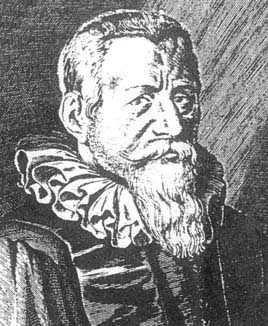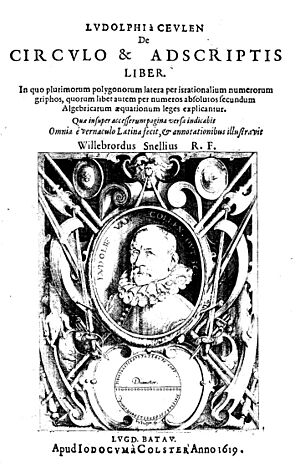Ludolph van Ceulen facts for kids
Quick facts for kids
Ludolph van Ceulen
|
|
|---|---|
 |
|
| Born | 28 January 1540 Hildesheim, Bishopric of Hildesheim, Holy Roman Empire
|
| Died | 31 December 1610 (aged 70) |
| Known for | Ludolphine number |
| Scientific career | |
| Fields | Mathematics |
| Institutions | Leiden University |
| Notable students | Willebrord Snellius Frans van Schooten, Sr. |
Ludolph van Ceulen (born January 28, 1540 – died December 31, 1610) was a German-Dutch mathematician. He moved to the Netherlands and became famous for his work on the mathematical constant pi (π).
Contents
Life and Work
Ludolph van Ceulen moved to Delft around 1576. There, he taught fencing and mathematics. In 1594, he opened his own fencing school in Leiden.
Professor of Mathematics
In 1600, Van Ceulen became the first professor of mathematics at a new school. This school was called the Engineering School, or Duytsche Mathematique. It was started by Maurice, Prince of Orange, at the Leiden University.
He shared his teaching role with a surveyor and mapmaker named Simon Fransz van Merwen. This shows that the school wanted to teach practical skills. It was not just about learning theories from books.
New Teaching Methods
The lessons for this new Engineering School were planned by Simon Stevin. He was a personal advisor to Prince Maurice. At first, the professors at Leiden University did not fully accept Van Ceulen and Van Merwen. This was because they taught in Dutch instead of Latin.
Many university professors believed that practical subjects were not suitable for a university. However, they did not want to completely reject the new school. This was because Prince Maurice himself had founded it.
University Challenges
In 1600, the leaders of Leiden University heard that another university had hired a math professor. To keep up, Leiden University quickly hired their own mathematician, Rudolf Snellius. He was placed in the Faculty of Arts. This made sure that Van Ceulen and Van Merwen were seen as less important than the university's own math professor.
When the first students from the Engineering School were to graduate in 1602, the university still had concerns. They would only give degrees if Rudolf Snellius tested the students. This made sure that Van Ceulen and Van Merwen were seen as lower in rank.
However, Rudolf Snellius and his son Willebrord Snellius worked well with Van Ceulen. Willebrord Snellius later took over from his father. He also worked closely with Simon Stevin and the Engineering School. Ludolph van Ceulen passed away in Leiden in 1610.
Calculating Pi
Ludolph van Ceulen spent a large part of his life trying to find the exact value of pi (π). Pi is a special number used to calculate things about circles. He used methods similar to those used by Archimedes many centuries before him.
In 1596, he published a book called Van den Circkel ("On the Circle"). In this book, he shared pi calculated to 20 decimal places. Later, he managed to calculate it to 35 decimal places.
Even 20 digits of pi are more than enough for almost any real-world use. For example, if you had a perfect circle, the tiny movements of atoms would make most of those digits meaningless. People continued to calculate pi to even more digits mainly out of curiosity.
Legacy
After Ludolph van Ceulen died, the number he calculated for pi was named the "Ludolphine number".
- 3.14159265358979323846264338327950288...
This long number was carved onto his tombstone in Leiden. The tombstone was lost for a while but was found and restored in the year 2000.
His book, "De circulo & adscriptis liber", was translated into Latin after his death by Willebrord Snellius. In Germany, the number pi is sometimes still called the "Ludolphine number" in his honor.
See also
- Area of a circle


